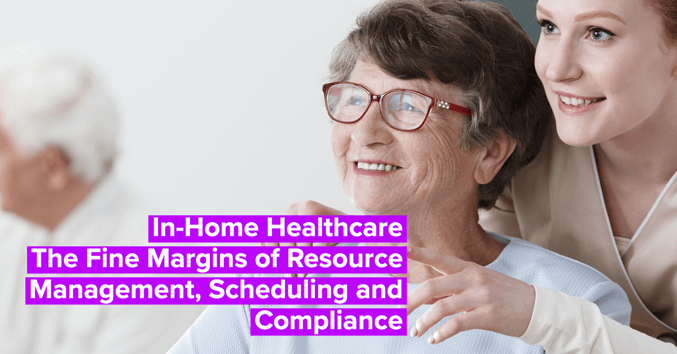In-Home Healthcare: The Fine Margins of Resource Management, Scheduling and Compliance
Posted by Alloc8, Mon, Sep 6, 2021

Australia's population is ageing — there is no doubt about this. A mixture of modernisation, social and economic improvement, and a shifted perception of concepts such as family and stability has led to increasing imbalance across different age strata. In 2017, there were 3.8 million Australians aged 65 and above, a figure equal to 15% of our total population. By 2057, it is expected that this will grow to 8.8 million or 22% of the population, hitting 12.8 million (25%) by the end of the century.
So Australians are living longer and, in many instances, enjoying a higher quality of life for longer, too. This is a good thing, but it does place additional strain on resources. As the number of Australians at working age diminishes in comparison with retiree numbers, the question is — how do we care for Australia's aged population without compromising national growth?
Increasing Reliance on In-Home Care
Another positive statistic from Australia's aged community — increasing numbers of Australia's elderly are able to remain in their own homes for longer, enjoying the surroundings they always have and receiving in-home healthcare on a part- or full-time basis. In 2020, there were over 1,450 organisations delivering home support services across the country, and home support and home care represent the two biggest areas of aged care expenditure, at $3.3 billion and $3.4 billion per year, respectively.
All of this points to a bright future for all Australians — a future in which we can look forward to living longer, healthier, happier lives, supported by a care system that provides for our needs. However, this cannot be achieved by accident. It can only come from a careful, considered and ongoing process of resource management and scheduling.
Modern Digital Solutions for Modern Problems
If Australia's ageing population is a symptom of modern societal shifts, it makes sense to utilise a modern solution as we overcome the problems this might bring. Ageing with safety, security and dignity should be a right for all of us, and with solutions like Alloc8 in place, it certainly can be.
The Alloc8 solution is designed to help organisations manage their resources and their assets in the right way, including perhaps their most important resource of all — their personnel. This fits beautifully into the broader in-home healthcare model, as it gives care and support providers the capability to get more from their resources, reducing costs and improving efficiency without ever compromising on levels of patient care.
Match Assets to Personnel and Personnel to Assignments
In-home healthcare is a highly specialised field, and this is reflected in the equipment, materials and other resources that are necessary to achieve the very highest levels of care. Alloc8 makes managing inventory and asset rosters easy, matching these assets with appropriate personnel skill and competency level to ensure the highest standards of care and compliance.
Significantly Reduce Scheduling and Management Delays
In-home care differs significantly from care administered within a centralised residential care home. With in-home care, patients are supported across a broad spectrum of distributed locations, making scheduling a complex task for providers. Alloc8's automated protocols reduce the time that these providers need to spend on scheduling, slashing timeframes by as much as 50% in some instances. With automated checks in place, delays are reduced without compromise on patient care.
Implement Training for Employees with Automated Prompts
In-home care practitioners need to be highly trained and accredited in their field. Alloc8 enables swift management of training and accreditation levels, which are added to employee profiles to ensure that the right personnel are assigned to the right jobs. Automated alerts let management teams know if data fields are missing from the profile, or if further training is required to meet minimum requirements.
Support Care in the Field with Real-Time Updates Across Mobile Devices
Real-time support and communication are critical the provision of high-level care in the field. With the Alloc8 app downloaded to smartphone and tablet devices, practitioners can receive all the necessary forms and documentation in real time, using GPS location stamps and digital signature capture to complete tasks quickly and easily. Management teams can create customised forms and checklists, delivering these tailored documents to specific employees without delay, facilitating a streamlined approach to care.
Prepare for the Future of In-Home Care with the Alloc8
The future of Australia — and of all Australians — depends on the proper management of in-home care resources and personnel. The Alloc8 solution is designed to achieve this, removing headaches and points of friction and leaving the way clear for the kind of care that Australia's elderly community both needs and deserves.
Schedule a demo of Alloc8 today and learn more about what the solution can help you achieve.
Topics: workforce scheduling tool, workforce scheduling tips, workforce scheduling software, workplace safety, alloc8, technology, health and safety, workforce management